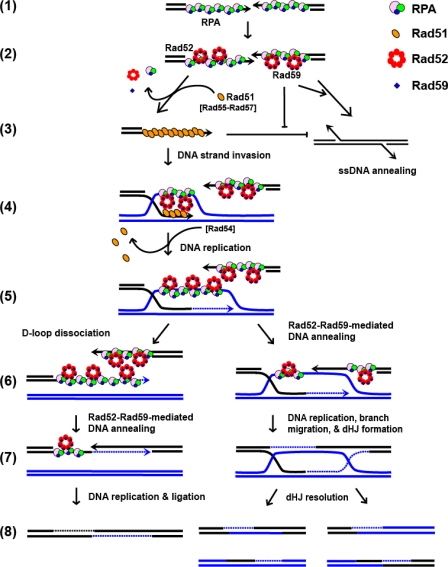FIGURE 7.
A model for selection among the homologous recombination pathways of DSB repair. The RAD51-dependent and -independent recombination pathways are represented by two biochemical reactions: Rad51-mediated DNA strand exchange and Rad52-mediated DNA annealing. Both pathways share the common step of DSB resection and RPA binding to the 3′-ssDNA tails (step 1). The species-specific interaction between RPA and Rad52 protein recruits Rad52 and Rad59 to the RPA-ssDNA complex (step 2). In the RAD51-independent pathway (step 3, right arrow), Rad52 promotes annealing of RPA-ssDNA with a complementary sequence from the other end of the processed DSB. Rad59 plays an important role at this step by enhancing DNA annealing activity of Rad52 and counteracting the inhibitory effect of Rad51 protein. In the RAD51-dependent pathway (step 3, left arrow), with the help by Rad52 (and Rad55-Rad57), Rad51 displaces RPA and Rad52 from ssDNA to form the presynaptic complex; formation of the Rad51 nucleoprotein filament strongly inhibits Rad52-mediated DNA annealing. DNA strand invasion and exchange with homologous DNA duplex follow (step 4). Next, Rad51 protein is stripped off DNA by Rad54 protein, and DNA replication initiates from the invading strand (step 5). After the newly synthesized DNA is unwound from the displacement-loop (D-loop) intermediate (step 6, left), it anneals to the second processed end of the DSB in a Rad52-dependent manner, aided by Rad59 (step 7, left). Further DNA synthesis, branch migration, cleavage, and ligation complete repair of the DSB (step 8, left). Alternatively, the second end of the DSB can be directly annealed to the D-loop by Rad52-Rad59 proteins (step 6, right). After DNA replication, branch migration, and DNA ligation, the double Holliday junction (dHJ) structure is formed (step 7, right). Resolution of the double Holliday junction structure completes repair of the DSB (step 8, right).

